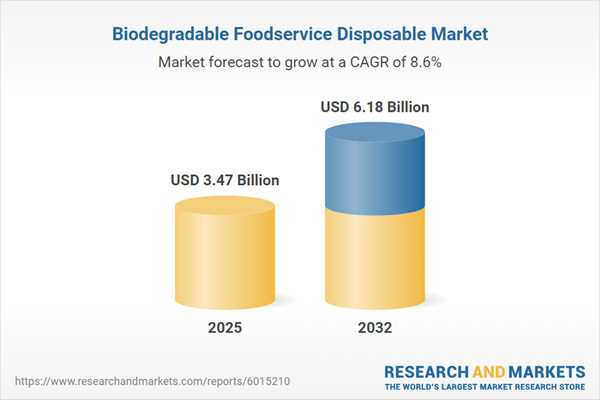Speak directly to the analyst to clarify any post sales queries you may have.
Senior executives are facing heightened decision-making challenges as the biodegradable foodservice disposable market evolves with changing regulatory and sustainability landscapes. Focused analysis is essential for leaders aiming to refine sourcing, advance compliance, and future-proof their organizations in an industry marked by dynamic operational requirements.
Market Snapshot: Biodegradable Foodservice Disposable Market
The biodegradable foodservice disposable market is experiencing steady growth supported by escalating demand for sustainable solutions in commercial and institutional operations. Market revenues are projected to expand from USD 3.19 billion in 2024 to USD 3.47 billion by 2025, with a compound annual growth rate (CAGR) of 8.61 percent. The total sector valuation is anticipated to reach USD 6.18 billion by 2032. This momentum is shaped by robust legislative mandates, novel compliance strategies, and an intensified focus on sustainability among both businesses and government procurement teams. Industry adoption is also being driven by customer preferences for environmentally conscious sourcing, as well as advancements in packaging innovation.
Scope & Segmentation
- Product Types: Portion containers, delivery and takeaway packaging, beverage cups (in various sizes), cutlery sets, square and compartment plates, flexible trays—all designed to support diverse hospitality and institutional needs.
- Material Types: Options such as bamboo fiber, polylactic acid, sugarcane fiber, wood pulp, and cornstarch blends, each chosen for compatibility with compostability and sustainability priorities.
- End Use Industries: Coffee shops, catering businesses, hotels, restaurants, institutional operators, campuses, healthcare providers, and accommodation companies utilize biodegradable disposables to align with purchasing policies and regulations.
- Sales Channels: Direct enterprise sales, distributor and wholesaler partnerships, e-commerce platforms, supermarkets, and convenience retailers meet the procurement diversity needed across local and global markets.
- Compostability Options: Availability of both home and industrial compostable formats enables tailored solutions to fit local regulations and institutional sustainability frameworks.
- Regional Coverage: Analysis spans the Americas (including the United States, Canada, Brazil), Europe, Middle East, Africa, and Asia-Pacific, with focused insights on China, India, Japan, and Australia to illustrate regional differences in product uptake and legislative impact.
- Company Coverage: The report profiles Huhtamaki Oyj, Pactiv Evergreen, Amcor plc, International Paper Company, NatureWorks LLC, BASF SE, Eco-Products, Vegware, Sabert, and Fabri-Kal LLC, highlighting their approaches to market challenges and innovation.
Key Takeaways
- Sustainability imperatives continue to spur significant product innovation, affecting development cycles and the procurement landscape for institutional buyers.
- Companies are enhancing visibility across their supply chains, investing in renewable materials and transparent reporting systems to ensure regulatory compliance and fulfill sustainability pledges.
- Implementation of closed-loop systems, such as compostable collection and targeted recycling programs, merges operational efficiency with ecological responsibility, reinforcing value propositions for stakeholders.
- Advanced digital tools, including blockchain-enabled labeling, are streamlining compliance authentication and strengthening trust with procurement officers and partners responsible for adherence.
- Manufacturers and suppliers are refining product portfolios and adjusting go-to-market strategies to better serve institutional priorities and shifting compliance targets.
- Material suppliers, packaging manufacturers, and waste management providers are collaborating more closely, accelerating adoption of circular models that appeal to sustainability-focused organizations.
Tariff Impact
In the United States, active tariffs on inputs such as polylactic acid, cornstarch, and bamboo fiber are causing elevated manufacturing costs, prompting a renewed focus on regional and domestic sourcing. Industry participants are expanding North American manufacturing, deepening ties with local agricultural suppliers, and adapting pricing strategies accordingly. Nearshoring is gaining prominence as companies seek to buffer supply chains against external disruptions and enhance overall resilience.
Methodology & Data Sources
This report combines primary research, including interviews with value chain stakeholders and on-site facility visits, with environmental lifecycle assessments. Market projections rely on peer-reviewed modeling to support accessible and actionable insights for industry leadership.
The Biodegradable Foodservice Disposable Market: Why This Report Matters
- Guides senior executives through regulatory, technological, and sourcing complexities unique to the biodegradable foodservice disposable market.
- Supports informed procurement with in-depth segment and regional analysis, strengthening both tactical and long-range planning.
- Delivers intelligence to help achieve sustainability targets and maintain competitive advantage as the sector adapts to evolving industry demands.
Conclusion
To sustain leadership in biodegradable foodservice disposables, organizations must navigate changes in regulation and sourcing with agility. Strengthened sustainability practices and transparent operations are crucial to meeting evolving industry expectations.
Additional Product Information:
- Purchase of this report includes 1 year online access with quarterly updates.
- This report can be updated on request. Please contact our Customer Experience team using the Ask a Question widget on our website.
Table of Contents
3. Executive Summary
4. Market Overview
7. Cumulative Impact of Artificial Intelligence 2025
Companies Mentioned
The companies profiled in this Biodegradable Foodservice Disposable market report include:- Huhtamaki Oyj
- Pactiv Evergreen, Inc.
- Amcor plc
- International Paper Company
- NatureWorks LLC
- BASF SE
- Eco-Products, Inc.
- Vegware Limited
- Sabert Corporation
- Fabri-Kal LLC
Table Information
| Report Attribute | Details |
|---|---|
| No. of Pages | 198 |
| Published | October 2025 |
| Forecast Period | 2025 - 2032 |
| Estimated Market Value ( USD | $ 3.47 Billion |
| Forecasted Market Value ( USD | $ 6.18 Billion |
| Compound Annual Growth Rate | 8.6% |
| Regions Covered | Global |
| No. of Companies Mentioned | 11 |









